|
A round drum is a sacred symbol for many reasons. The Great
Spirit created all things above and below the earth, and all these are round,
except for some stones. The sun, the moon, and the earth as we see their
horizons form a complete circle. The sky is round where it meets the horizon
even though it forms a bowl overhead. Everything that breathes -- the
two-legged, the four-legged, and the winged-of-the-air -- are round. All the
plants that grow on the earth emerge from the ground with a round stem and
penetrate the earth with round roots. Because the Great Spirit has created
everything in a circle that man experiences, except for some stones, man should
look upon a circle as a sacred symbol of life. The reason that some stones were
not created round is that these sharp edged stones were usually meant for
destructive purposes; therefore, if they were not meant to help sustain life,
the Great Spirit chose to exclude them from the sacred circle.
The circle can be seen in every aspect of life. Each day and
night are a complete cycle as the sun and the moon move in their arcs (which is
part of a complete circle) across the sky; consequently, time itself is a circle
from birth, to childhood, to adulthood, to old age, and finally to death -- from
dust to dust. The examples around us are endless: the fire pit is usually round,
a tipi or hogan is round, water makes a complete cycle, at ceremonies everyone
is seated in a complete circle, and even the four winds move in circles.
Many other ornaments and sacred objects were also made in the
shape of a circle. If the object was not divided into sections, it represented
the universe and time. If the circle was filled with blue, it represented the
sky; if it was filled with red, it meant the sun; and if it was divided into
four sections, it symbolized the four directions or winds. The colors had
several meanings but the drawings and the divisions were usually understood
between most tribes.
Among the Oglala Sioux a yellow circle meant a month or moon,
a black circle meant night, a half red circle meant a day, while a multi-colored
circle or half circle represented a rainbow. All of the above reasons that
symbolize the sacred meanings of a round drum do not give the full definition of
the round drum's deep religious significance. I believe that on the first level
of the spirit of a drum, the drum maker must realize that two living things, a
tree and an animal, sacrificed their lives in order that the drum could be made.
A deeper understanding into the spiritual meaning of a round drum can be
realized when a novice understands that the "old ones" of all tribes
not only sang and listened to a medicine drum song -- they lived the song! The
songs and the drum were a way of accomplishing changes within oneself in order
to bring their spirit into accord with the Great Spirit, the universe of life,
and their fellow man.
The drum beats which represent the heart beat of all living
things in their world, when combined with words, seem to pull all thoughts into
a tangible form which can be dealt with. To an outsider, it may appear to be an
unmelodious series of sounds and words, but to those participating, these same
sounds and words are related phrases which have an infinite amount of meaning.
They reach deep into the heart and minds, the very souls, of those who
understand the deeper meanings; and with this knowledge it is easy to see why
most tribes have a song for every aspect of life, and also why these songs were
a special part of most ceremonies.
Making A Round Medicine Drum
Round drums are made similar to octagon drums, except for the
obvious reason: the frames are not cut into eight parts because the frames will
be made to form a continuous oval shape. The frames will be made from a
three-inch wide cedar or willow board or from a tree limb or trunk that is
smooth and without a taper. The diameter of the round drum can be from three
inches to four feet, depending on the materials available and the specific use
of the drum. The larger the diameter the more bass tones, conversely the smaller
the diameter the higher the pitch until a three-inch drum sounds more like a
rattle. The first round drum a novice builds should be either very small or
should be about 14 inches in diameter, because these are the easiest to handle
during the frame forming.
If a round drum is to be made from a tree limb, a very pliable
green wood should be used. Willow and cedar meet this requirement, and they are
also considered sacred for their fire-making qualities, medicinal uses and the
many other functional items that can be made from them. Willow actually works
best because it has less taper to the limbs or the young tree trunks, and it can
be easily bent into a circular shape when it is still green. It can also be
easily steamed and bent after it has dried.
Once the willow or cedar limb has been selected, I remove all
the bark and twigs or leaves while making the limb as smooth as possible. This
is also a good time to check for any flaws in the wood grain, or large knots
that will become weak spots when the frame is bent. From personal experience,
there is nothing worse than many hours of work wasted because a flaw was not
seen early in the drum making project.
After the limb is clean and smooth I cut it to length which is
determined by the circumference of the drum desired, plus any overlapping of the
ends. All this can be judged by pulling the limb into the rough circle desired,
or the length can be found more exact by the formula: C = ÕR2 (plus the overlap).
C = Circumference of a circle
Õ = pi, 3.1416
R = Radius of a circle |
 |
|
| |
| Next the ends of the drum frame must be cut and shaped so they
will closely match and make a smooth connection. This is very important because
a loose fit of the ends will cause a tone rattle to develop. Also, the ends must
be trimmed to compensate for the rawhide bindings which can also cause a bulge
under the drum head. To make this overlap, I mark the ends three or four inches
back from the tips with a knife cut completely around the limb ends. These marks
must be exactly the same from their respective ends in order to make a near
perfect connection. Another method of making this overlap is to make a long
taper about a third of the way back from the ends; but if this is done, the
frame must be cut longer because of the amount of overlap. |
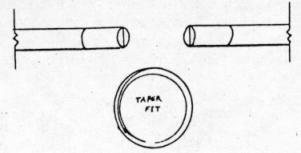 |
|
| |
| After the overlap has been marked, I draw a vertical line that
bisects the limb ends. These opposing bisecting lines should be located so that
the inside flat surface faces to the outside of the frame circle. To remove the
overlapping material, a knife, a saw or a sharpened rock can be used. |
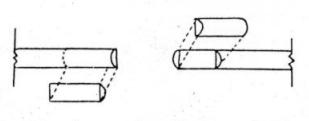 |
|
| |
| After the ends have been cut for the interlocking connection,
I next remove approximately 1/8" to 1/4" of the diameter of the ends.
This amount depends on the thickness of the rawhide I will be using to bind the
ends together. Again, this is very important, because if not done correctly, a
dip or bulge in the drumhead will cause a tone rattle. |
 |
|
| |
After all the difficult shaping and trimming has been done,
the bending of the limb into the completed circular shape can be the most
difficult, because if the wood has dried out or has a hidden weak spot, all the
previous labor will be destroyed. Usually, I try to get someone to help me bend
the frame into shape, because holding the frame in place and tying the rawhide
binding in place at the same time is almost impossible to do alone.
Using a combination of strength, luck, heat, and water, the
frame can be bent into a complete circle. Strength is required to bend the limb
into a circular frame; because as the circle becomes more complete, the stress
is increased on the wood fibers. To ease this strain, the limb can be held
momentarily over a fire or any heat and the moisture in the wood will begin to
steam which allows the wood fibers to slip which in turn relieves the stress.
| When the two ends finally overlap, I bind them together with
rawhide cordage that hopefully I have remembered to cut beforehand. I tightly
wrap the rawhide from the center of the overlap toward one end and then back
again. During this overlapping of the rawhide wrapping, I make sure the second
layer is wrapped very close together with no ridges or gaps because a smooth
surface gives the best finish. If the rawhide has been wrapped tight enough, the
frame will stay together and will become stronger after the rawhide has dried
and shrunk. |
 |
If the drum frame needs any realignment to perfect the circle,
it can be steamed and re-shaped; but the rawhide binding must be kept dry. Also
if the limb cannot be easily bent into shape, the inside of the frame can be
trimmed until the inside thickness is decreased and the stress on the wood will
also be decreased.
| Another type of round drum can be made from either standard
lumber of the same type used for the octagon drums or a large, green cedar or
willow trunk or limb can be split into a thin board. Either of these can be
trimmed for the overlap and then steam bent into a round drum frame. The overlap
of the ends can be wrapped with rawhide cordage or it can be drilled and
dowel-pinned and then wrapped in rawhide. If dowel pins are used, the holes
should be drilled at an angle. This gives more strength to the frame because the
angle prevents the dowel pins from being pulled straight out. |
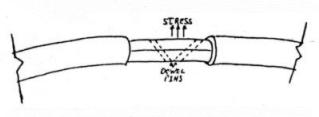 |
|
| |
| The main problem with using standard lumber is that it is
usually kiln-dried and therefore cannot be bent into a tight circle without
splintering. To lessen the stress of the bending, I usually cut into the lumber
to a depth of 50% to 75% of the thickness. These cross-cuts are stress relieving
and should be made about two inches apart around the entire inside of the frame.
As the frame is bent these cuts will collapse and allow the drier woods to be
shaped into a round frame. |
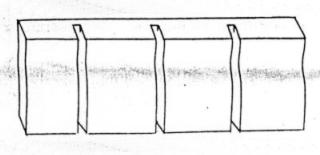 |
|
| |
| Without a modern saw these same cuts can be made using a
sharpened stone which is held between the feet while the frame is pulled
laterally across the stone edge. Actually, I have found the stone cutters make
the best cross-cuts because they cut the grooves in a "V" shape which
almost disappears after the frame is finished. |
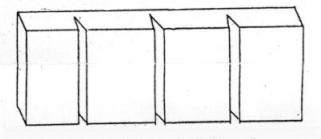 |
|
| |
| Another method of binding the two ends together is to make a
rawhide sleeve that can be slipped over the overlapping ends and tightened with
a rawhide draw string. |
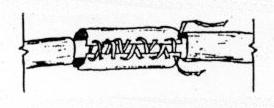 |
|
| |
| The cutting and the fastening of the rawhide drumhead is done
in the same manner as the octagon drum; but there are several variations to this
basic pattern. Sometimes instead of the crisscrossing of rawhide on the backside
of the drum, a rawhide drawstring is stitched around the drumhead edge. This is
pulled very tight and secured into a complete circle. As this drawstring is
tightened, it pulls the slack out of the drumhead. A handhold is made across the
back with a cross pattern of two or more cords tied to the drawstring or the
edge-holes in the drumhead. Sometimes these are wrapped at the center crossing
point to make a better handhold. |
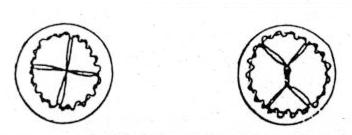 |
|
| |
In more recent times, brass tacks or nails have been used to
fasten the drumhead to the back of the frame, but the problem with tacks or
nails is that they vibrate loose and need constant attention. Also, the tacks
will begin to vibrate or rattle, even though they do not appear to be loose.
There are as many variations to securing the drumhead as there
are materials available and varieties of skills of drum makers. I have found
that the simplest methods, which at the same time keep the drum tight and free
of tone rattles, are the best methods.
Painting A Drum
The paint should be made from natural material such as
powdered rock, tree sap, tree bark, or plant material. If this cannot be done,
an acrylic paint will work because it is somewhat flexible after it dries. I
have found the drum will retain its colors better if it is painted while still
damp. Also, it will not chip or flake as easily.
Other than being damp and clean, no other preparation of the
drum is necessary.
An appropriate design can be found in the following books: The
Apache Indians by Thomas E. Mails, Mystic Warriors of the Plains by Thomas E.
Mails, and Indian and Eskimo Artifacts by Charles Miles. When selecting a
design, I try to let the drum tell me what should be painted on it. Sometimes
only I know what the symbols mean, because each drum has its own voice or
spirit. This message may be a very special voice meant only for one person to
hear and feel. When the design is chosen, if it is the "right" one, it
will stand out from all the rest.
Making A Drumstick
I usually make the drumstick from a hardwood such as oak,
hickory, or willow. The drumstick will need to withstand many hours of hard use,
so a durable, strong wood is needed. I have found that the length should be nine
to twelve inches. The diameter should taper from a head size of 1/2 inch to 3/4
inch down to the hand-hold diameter of 3/8 inch.
To protect the drum-head hide, the head of the drumstick must
be padded. I sometimes wrap the head with wool or yarn until a small ball is
formed on the top two inches of the head. Most of the time I use deer or elk
hair, bound tightly in a felt cocoon. To make the latter, I first sew a double
layer of felt into a sleeve about four inches long. The sleeve is placed onto
the drumstick head with approximately a one-inch overhang. The other end of the
felt sleeve is secured to the drumstick with sinew pulled very tight. Over the
sinew, rawhide cordage is tightly wrapped and tied off. I then tightly pack the
deer hair into the pocket created by the secured sleeve, making sure the
drumstick head remains in the center of the pocket. When no more hair can be
packed into the pocket, I sew the pocket closed, using a common whip or
slip-stitch. If the padded head feels too soft, I stitch it again with sinew and
use a larger stitching pattern the second time. This should be pulled very
tight, which will also help pack the hair tight.
How to Care for a Hand Drum
A drum is a special object that has many meanings to different
tribes. Although a drum's form, its treatment and usage may differ across North
America, there are many similarities the drums share. Above all else, each drum
must be treated with respect because a tree and an animal have sacrificed their
lives for the drum. The results are the quality of the drum.
If the drum is too tight, it will make a "tinny"
sound. This may be for a number of reasons. The tension may have been too great
when you were making the drum, and as the hide dried, the skin became so tight
the drum lacks a good, deep tone. If this is the case, the drum can be re-soaked
for four to six hours and restrung a little looser; but this is only to be done
if any of the following methods fail: A slight loosening will occur if mink oil
is rubbed into the backside of the drumskin. If the weather becomes very dry or
if the drum is stored in an air-conditioned area, the drum will tighten. A damp
towel wrapped around the drum allow moisture to loosen the drum again. If
because of weather the drum is temporarily tight, a few tablespoons of water
swished around the inside of the drum and poured out will also loosen the drum.
Try not to allow the outside of the drum to get wet because the painted design
may become damaged from the water.
A drum that is too loose will sound like cardboard.
Traditionally, a temporary correction can be made over an open fire; however, a
blow dryer will quickly dry out the hide and restore the drum to its normal
sound. Also, a drum that is too loose can be held over a range or even put into
an oven on low heat. This is a bit risky because the hide can become baked and
it may even split. Whatever the method, keep "thumping" the hide until
a good tone is heard, then stop immediately, because the drum will continue to
tighten a few minutes after it is removed from the heat.
If the hide splits, the drum can be given its last rites. A
major split in the hide usually means the end of the drum, although some parts
can be reused. The frame can be reused and the lacing can also be reused. If the
rest of the drum-head is still good, it can be used to make new lacing.
Sometimes if the split is a very small one, a piece of rawhide cut slightly
larger than the hole can be glued over the back-side of the hole. This prevents
the hole from enlarging. A pinhole can usually be ignored if it occurs in a
location on the drum-head that is seldom struck.
The lifespan of a drum will depend totally on the factors of
how the drum is cared for during use and during storage; it should never be too
dry and hot, nor too moist and moldy. With good care, the drum will last many
years, even if it, is used two or three times a week.
If a good drumstick is always used, the chances of damage
during use will also be kept to a minimum. A drumstick in good condition will
prevent scratches and scars to the drumheads These can cause holes and cracks
that will ruin the drum, so the drumstick should be checked for wear.
From The Tracker magazine, Summer 1983,
published by the Tracker School.
For more articles from The Tracker magazine, visit the
Tracker Trail website. |